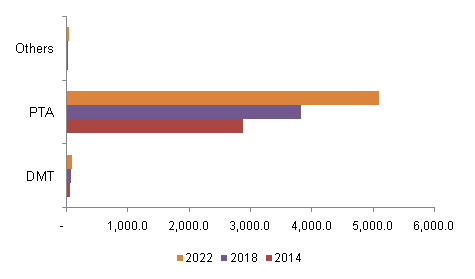The global market for Polymethyl Methacrylate (PMMA) is expected to reach USD 10.87 billion by 2020, according to a new study by Grand View Research, Inc. Growing demand for LED flat panels and LED TVs is expected to be one of the key factors driving PMMA demand, especially in Asia Pacific, which is a major hub for electronic manufacturing. Growth of major end-use industries including electronics, automotive and signs & displays, mainly in emerging economies of China and India, are expected to boost the demand for PMMA over the forecast period. Grand View Research further observes that increasing R&D activities for developing bio-based PMMA coupled with emerging applications for optical grade PMMA in medical and healthcare, coatings and emulsions and solar power sectors is expected to drive its future market.
PMMA extruded sheets alone accounted for over 55% of global market volumes in 2012. Extruded PMMA sheets find wide applications in numerous industries including electronics, signs and display, construction and automobiles among others. Owing to its new found use in coatings and emulsions market, PMMA beads (powder) form is expected to be the fastest growing market, at an estimated CAGR of 7% from 2013 to 2020. Cell cast sheet and blocks is another PMMA form widely used for construction activities owing to its impact strength and weather resistance.
View
summary of this report @ http://www.grandviewresearch.com/industry-analysis/polymethyl-methacrylate-pmma-industry
Global PMMA market volume share, by product, 2012
Further Key findings from the study
suggest:
- Global PMMA market volume is expected to reach 2.85 million tons by 2020, growing at a CAGR of 6.1% from 2013 to 2020
- Signs and display applications emerged as the largest market for PMMA, with over 35% of global volumes in 2012. The electronics industry, including flat display screens, is expected to be the fastest growing application market for PMMA at an estimated CAGR of 7.7% over the next six years. In addition, broadening application of PMMA in other end use industries such as furniture and interiors, sanitary ware, fashion and apparel among others, is expected to boost its consumption over the next six years
- Asia Pacific dominated the PMMA market, accounting for over 65% of the global demand in 2012. Along with being the largest market, Asia Pacific is also expected to be the fastest growing market for PMMA, at an estimated CAGR of 7.3% from 2013 to 2020. Europe is expected to witness moderate growth rate in the near future, while Middle East and Africa and Central and South America are expected to show above average growth for PMMA demand
- Growth of electronics industry, mainly in Taiwan, South Korea and China is expected to boost the demand for PMMA over the next six years. Asia Pacific is considered to be the most attractive market, with relaxed regulations and cheap availability of labor and technology. Increased production of LED flat panels and LEDTVs has given a boost to PMMA demand in recent years, a trend which is expected to continue over the forecast period
- The global market for PMMA is highly consolidated and dominated by top multinational corporations. Top four companies namely, Mitsubishi Rayon, Altuglas International, Evonik Industries and Chi Mei Corporation account for approximately three-fourth of the total PMMA produced worldwide in 2012
Browse All Reports of
this category @ http://www.grandviewresearch.com/industry/bulk-chemicals


